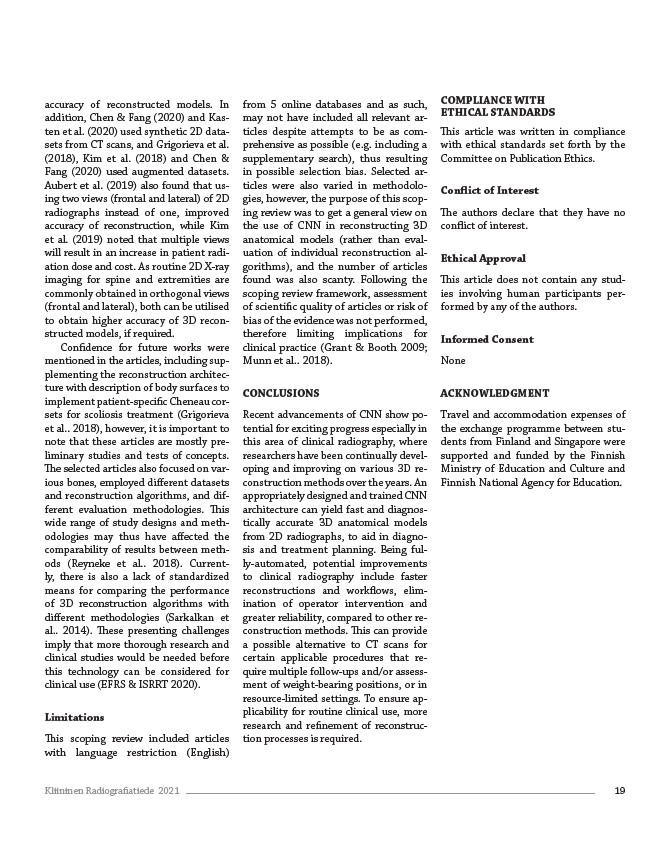
accuracy of reconstructed models. In
addition, Chen & Fang (2020) and Kas-ten
et al. (2020) used synthetic 2D data-sets
from CT scans, and Grigorieva et al.
(2018), Kim et al. (2018) and Chen &
Fang (2020) used augmented datasets.
Aubert et al. (2019) also found that us-ing
two views (frontal and lateral) of 2D
radiographs instead of one, improved
accuracy of reconstruction, while Kim
et al. (2019) noted that multiple views
will result in an increase in patient radi-ation
dose and cost. As routine 2D X-ray
imaging for spine and extremities are
commonly obtained in orthogonal views
(frontal and lateral), both can be utilised
to obtain higher accuracy of 3D recon-structed
models, if required.
Confidence for future works were
mentioned in the articles, including sup-plementing
the reconstruction architec-ture
with description of body surfaces to
implement patient-specific Cheneau cor-sets
for scoliosis treatment (Grigorieva
et al.. 2018), however, it is important to
note that these articles are mostly pre-liminary
studies and tests of concepts.
The selected articles also focused on var-ious
bones, employed different datasets
and reconstruction algorithms, and dif-ferent
evaluation methodologies. This
wide range of study designs and meth-odologies
may thus have affected the
comparability of results between meth-ods
(Reyneke et al.. 2018). Current-ly,
there is also a lack of standardized
means for comparing the performance
of 3D reconstruction algorithms with
different methodologies (Sarkalkan et
al.. 2014). These presenting challenges
imply that more thorough research and
clinical studies would be needed before
this technology can be considered for
clinical use (EFRS & ISRRT 2020).
Limitations
This scoping review included articles
with language restriction (English)
from 5 online databases and as such,
may not have included all relevant ar-ticles
despite attempts to be as com-prehensive
as possible (e.g. including a
supplementary search), thus resulting
in possible selection bias. Selected ar-ticles
were also varied in methodolo-gies,
however, the purpose of this scop-ing
review was to get a general view on
the use of CNN in reconstructing 3D
anatomical models (rather than eval-uation
of individual reconstruction al-gorithms),
and the number of articles
found was also scanty. Following the
scoping review framework, assessment
of scientific quality of articles or risk of
bias of the evidence was not performed,
therefore limiting implications for
clinical practice (Grant & Booth 2009;
Munn et al.. 2018).
CONCLUSIONS
Recent advancements of CNN show po-tential
for exciting progress especially in
this area of clinical radiography, where
researchers have been continually devel-oping
and improving on various 3D re-construction
methods over the years. An
appropriately designed and trained CNN
architecture can yield fast and diagnos-tically
accurate 3D anatomical models
from 2D radiographs, to aid in diagno-sis
and treatment planning. Being ful-ly-
automated, potential improvements
to clinical radiography include faster
reconstructions and workflows, elim-ination
of operator intervention and
greater reliability, compared to other re-construction
methods. This can provide
a possible alternative to CT scans for
certain applicable procedures that re-quire
multiple follow-ups and/or assess-ment
of weight-bearing positions, or in
resource-limited settings. To ensure ap-plicability
for routine clinical use, more
research and refinement of reconstruc-tion
processes is required.
COMPLIANCE WITH
ETHICAL STANDARDS
This article was written in compliance
with ethical standards set forth by the
Committee on Publication Ethics.
Conflict of Interest
The authors declare that they have no
conflict of interest.
Ethical Approval
This article does not contain any stud-ies
involving human participants per-formed
by any of the authors.
Informed Consent
None
ACKNOWLEDGMENT
Travel and accommodation expenses of
the exchange programme between stu-dents
from Finland and Singapore were
supported and funded by the Finnish
Ministry of Education and Culture and
Finnish National Agency for Education.
Kliininen Radiografiatiede 2021 19